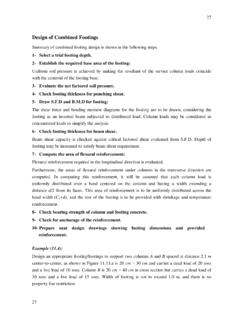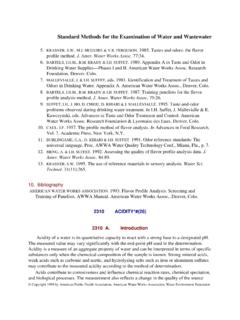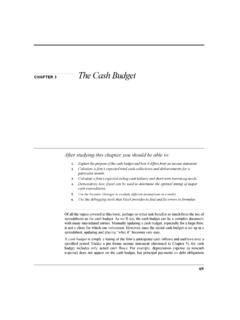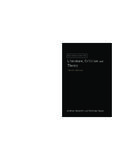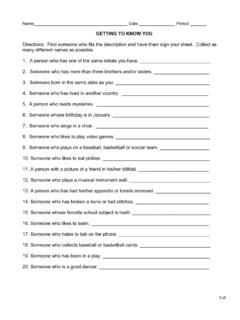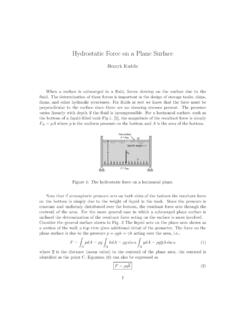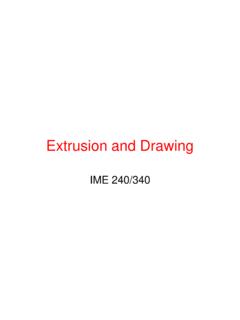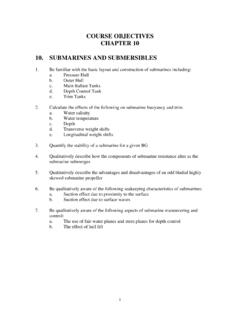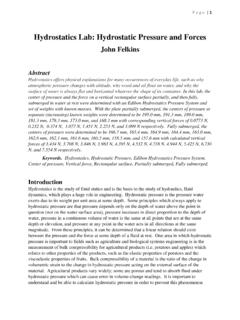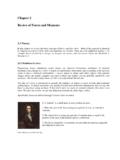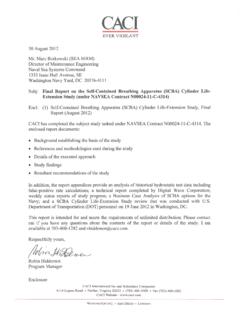Transcription of Force on a Curved Surface due to Hydrostatic Pressure
1 Page (64) Al-astal Eng. Ahmed Al-Agha Eng. Ruba Awad Static Forces on Surfaces-Buoyancy Fluid Mechanics Force on a Curved Surface due to Hydrostatic Pressure If the Surface is Curved , the forces on each element of the Surface will not be parallel (normal to the Surface at each point) and must be combined using some vectorial method. The most significant method to solve these types of problems is to calculate the vertical and horizontal components, and then combine these two forces to obtain the resultant Force and its direction. There are two cases: Case I: if the fluid is above the Curved Surface : Horizontal Component ( ): The resultant horizontal Force of a fluid above a Curved Surface is: = Resultant Force on the projection of the Curved Surface onto a vertical plane ( along line AC in the above figure).
2 We know that the Force must be normal to the plane, so if we take the vertical plane, the Force will act horizontally through the center of Pressure of the projected vertical plane as shown in figure below, and we can use Pressure diagram method. Page (65) Al-astal Eng. Ahmed Al-Agha Eng. Ruba Awad Static Forces on Surfaces-Buoyancy Fluid Mechanics Vertical Component ( ): Because the fluid is at rest, there are no shear forces on the vertical edges, so the vertical component can only be due to the weight of the fluid. The resultant vertical Force of a fluid above a Curved Surface is: = Weight of fluid directly above the Curved Surface and will act vertically downward through the center of gravity of the mass of fluid as shown in figure below.
3 R =Weight of fluid above the Curved Surface = gV= V R cp Page (66) Al-astal Eng. Ahmed Al-Agha Eng. Ruba Awad Static Forces on Surfaces-Buoyancy Fluid Mechanics Resultant Force ( ): The overall resultant Force is found by combining the vertical and horizontal components vectorialy: R= R +R This resultant Force acts through point O at an angle ( ) with R The position of O is the point of intersection of the horizontal line of action of R and the vertical line of action of R as shown in figure below. =tan R R Case II: if the fluid is below the Curved Surface : Page (67) Al-astal Eng. Ahmed Al-Agha Eng.
4 Ruba Awad Static Forces on Surfaces-Buoyancy Fluid Mechanics The calculation of horizontal Force R is the same as case I, but calculation of vertical Force R will differ from case I. Vertical Force component in case of fluid below Curved Surface : If the Curved Surface AB is removed, the area ABDE will replaced by the fluid and the whole system would be in equilibrium. Thus the Force required by the Curved Surface to maintain equilibrium is equal to that Force which the fluid above the Surface would exert (weight of fluid above the Curved Surface ). The resultant vertical Force of a fluid below a Curved Surface is: R = Weight of the imaginary volume of fluid vertically above the Curved Surface .
5 Problems 1. The gate shown in figure is m wide and it is a quarter circle hinged at H. Determine the horizontal Force P required to hold the gate in place. Solution 1. Calculate the horizontal component of Hydrostatic Force (R ): As stated above, the value R is calculated on the projection on vertical plane as following: R =Volume of Pressure diagram =Area width R =12 (1000 ) R = N Page (68) Al-astal Eng. Ahmed Al-Agha Eng. Ruba Awad Static Forces on Surfaces-Buoyancy Fluid Mechanics 2. Calculate the vertical component of Hydrostatic Force (R ): R =Weight of fluid above the Curved Surface = gV V=Area of quarter circle Width V= 4 m R =1000 N R acts at distance 4R3 =4 = from the circle center The weight of the gate is not given, so neglect it.
6 The free body diagram of the whole system is: By taking summation moment about the hinge: M@ = P +R P + P= N . Page (69) Al-astal Eng. Ahmed Al-Agha Eng. Ruba Awad Static Forces on Surfaces-Buoyancy Fluid Mechanics 2. The gate shown in figure below consists of a quarter of a circular cylinder and is used to maintain a water depth of 4 m. Determine the weight of the gate per meter of length. Solution Assume the width of whole system is 1m 1. Calculate the horizontal component of Hydrostatic Force (R ): R =Volume of Pressure diagram=Area width R =F +F F =volume of rectangle F =(1000 3) 1 1 F =29430 N F =volume of triangle F =12[1000 (4 3)] 1 1 F =4905 N 3.
7 Calculate the vertical component of Hydrostatic Force (R ): R =Weight of fluid the Curved Surface = gV Note that there is no water above the gate, so the value of R equals the weight of imaginary fluid above the gate as shown below: Page (70) Al-astal Eng. Ahmed Al-Agha Eng. Ruba Awad Static Forces on Surfaces-Buoyancy Fluid Mechanics The most important note that the imaginary fluid is above the gate to reach free Surface w=w +w w = rectangle volume w =9810 (3 1) 1=29430 N w = quarter circle volume w =9810 1 4 1= N R =w +w R =29430+ N. Location of R : w located at the center of rectangle at distance 12 from hinge w located at the center of quarter circle at distance 1 4R3 from hinge =1 4 13 = m To find the location of R take the moment about hinge: R x=w +w2 x=29430 + x= m Now, draw the free body diagram for the entire system: Page (71) Al-astal Eng.
8 Ahmed Al-Agha Eng. Ruba Awad Static Forces on Surfaces-Buoyancy Fluid Mechanics The weight of the gate is subjected on the center of the gate which is a quarter circle ( at distance from hinge) By taking summation moment about the hinge: M@ = w +F +R w +4905 + w= N . Page (72) Al-astal Eng. Ahmed Al-Agha Eng. Ruba Awad Static Forces on Surfaces-Buoyancy Fluid Mechanics Buoyancy When a body is submerged or floating in a static fluid, the resultant Force exerted on it by the fluid is called the buoyancy Force . Buoyancy Force = and this Force will act vertically upward through the centroid of the volume of fluid displaced, known as the center of buoyancy.
9 Archimedes principle Archimedes Principle states that the buoyant Force has a magnitude equal to the weight of the fluid displaced by the body and is directed vertically upward. F = g V (Upward ) Problems 1. A 1-m-diameter cylindrical mass, M, is connected to a 2-m-wide rectangular gate as shown in figure below. Determine the required value for M if h = Solution Firstly, we calculate the tension in the cable. The free body diagram for the gate is shown below: F =Volume of triangle Page (73) Al-astal Eng. Ahmed Al-Agha Eng. Ruba Awad Static Forces on Surfaces-Buoyancy Fluid Mechanics F =12 (9810 ) 2= N M@ = T 4=F T 4= T= N Now we take the free body diagram for the cylindrical mass: The Force F is buoyant Force F = g V V =volume of object immersed in water V = 4 1 ( 1)= m F =1000 N F = T+F =Mg Mg= + N M= kg.
10 Page (74) Al-astal Eng. Ahmed Al-Agha Eng. Ruba Awad Static Forces on Surfaces-Buoyancy Fluid Mechanics 2. A wooden rod weighting 25N is hinged at one end, the rod is 5m long and uniform cross section, and the support is 3m below the free Surface . At what angle will it come to rest when it is allowed to drop from a vertical position? The cross section of the rod is 10 cm2. Solution Let X is the length of rod immersed in water, the free body diagram of the rod is shown below: Page (75) Al-astal Eng. Ahmed Al-Agha Eng. Ruba Awad Static Forces on Surfaces-Buoyancy Fluid Mechanics From the above figure, we note the following: The weight of the rod (25N) act at the centroid of rod ( at distance from hinge).
